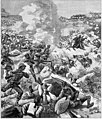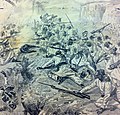Mengesha Yohannes
Ras Mengeša Yohannes ( Tigrinya መንገሻ ዮሐንስ , Mɛngɛša also transcribed as Mengesha, Mangasha or Mangašā ) (* 1865 in Tigray , Abyssinia ; † December 29, 1906 or early 1907 in Ankober , Abyssinia) was a Tigrin or Ethiopian prince and military leader. There were different statements about whether Ras Mengeša was a nephew, adopted son, illegitimate or legitimate son of the Ethiopian Emperor Yohannes IV .
Heir apparent and governor
After Yohannes' eldest son and Crown Prince Araya Selassie Yohannes died in 1888, Ras Mengeša served in Araya's place in the Ethiopian army . The emperor, who was fatally wounded in the battle of Gallabat in 1889, declared Ras vielteša to be his "natural son" and heir to the throne while still on his deathbed. Although Ras Alula Engida , his father's most respected military leader, initially supported Ras Quantityša and urged him to proclaim himself emperor, the young heir to the throne was still too inexperienced to be able to assert himself against Menelik II of Shewa . The imperial army had dispersed after Yohannes' death, and Ras Mengeša's home province of Tigray was weakened by war, famine and intra-dynastic rivalries. With the help of the Italians, who had initially been defeated by Yohannes IV and Ras Alula, Menelik, who had fought Yohannes for years, became the new emperor in 1889 in Ras vielze's place. Ras Quantityša, who had not succeeded in setting up a new large army against Menelik, had to submit first and was allowed to remain governor of Tigray. In the Uccialli Treaty , however, Menelik had ceded some areas of Tigray to the Italians, and more and more Ras Quantityša had to fight off the Italians who intended to expand their colony of Italian-Eritrea over the whole of Tigray.
Yohannes IV with son Araya Selassie
Opponents of Italy and Menelik II.
The relationship between Ras Mengeša and Ras Alula deteriorated when Ras Mengeša tried to negotiate with the Italians instead of fighting them further. In the Treaty of Mareb (Convention of Mareb), Ras Quantityša allied himself with the Italians against Menelik on December 7, 1891. The attacks by the Italians continued, however, and Ras Quantityša could not simultaneously wage a two-front war against the Italians and Menelik, who in turn negotiated with each other. After Ras Alula's mediation, Ras Quantityša submitted to Menelik again in May 1894, concluded an alliance against Italy with him in June 1894 (Convention of Entoto) and in December 1894 supported unsuccessfully Tigrin uprisings in Eritrea (uprising of the Bahta Hagos). Thereupon Italian troops began to invade Tigray and demanded that Menelik imprison Ras Mengeša. Despite the alliance with Menelik, Ras Quantityša initially remained on his own, but undertook a counterattack. The Battle of Coatit (Kwatit) ended in a draw on January 14, 1895, but Ras Mengeša had to retreat in view of the high losses and suffered an almost complete defeat the following day at Senafe , whereupon the Italians invaded Tigray and also Ras Quantityša's capital Mek ' ele could occupy. In October 1895, Ras Quantityša lost again at Debra Ailà , while Menelik made the Italians still offers to negotiate. It was only when the Italians had occupied almost all of Tigray that Menelik came to the rescue in November 1895. Together with Ras Alula, Ras Quantityša raised a new army, fought alongside Menelik at Amba Alagi in December 1895, and in March 1896 contributed significantly to the Ethiopian victory at Adua .
After Ras Alula's death, Ras Mengeša renewed his own throne ambitions, stopped paying taxes to the imperial central government and declared in 1898 that Menelik would no longer be recognized as emperor. Ras Quantityša raised an army, but most of it overran to the enemy. In February 1899, Ras Mengeša had to surrender to Menelik's General Ras Mekonnen and was taken to Ankober as a prisoner. Ras Mekonnen was initially the new governor in Tigray. With Ras Mekonnen's death in March 1906, Ras Quantityša's chances seemed to increase again, but only a little later Ras Quantityša also died under unexplained circumstances.
The province of Tigray was finally divided: in West Tigray Ras Quantityša's son Seyyum Mengeša (1887-1960) was appointed governor, in East Tigray Araya Selassie's son Gugsa Araya Selassie (1885-1932).
Individual evidence
- ↑ a b c d e f g h David Hamilton Shinn: Historical Dictionary of Ethiopia , pages 71f and 272ff. Scarecrow Press, Lanham 2013
- ↑ a b c d e f Andrzej Bartnicki, Joanna Mantel-Niećko: History of Ethiopia - From the beginnings to the present , part 2, pages 400, 415ff, 644f and 695. Akademie-Verlag, Berlin 1978
- ^ A b c d e f Paul B. Henze: Layers of Time - A History of Ethiopia , pages 160-173. C. Hurst & Co. Publishers, London 2000
- ↑ a b Enciclopedia Treccani : Mangascià (Italian)
- ↑ a b c d e f Andrzej Bartnicki, Joanna Mantel-Niećko: History of Ethiopia - From the beginnings to the present , part 1, pages 299ff, 317ff and 323–346. Akademie-Verlag, Berlin 1978
- ^ A b Dan Connell, Tom Killion: Historical Dictionary of Eritrea , pages 62 and 498. Scarecrow Press, Lanham 2010
| personal data | |
|---|---|
| SURNAME | Mengesha Yohannes |
| ALTERNATIVE NAMES | Mangasha Yohannes |
| BRIEF DESCRIPTION | Ethiopian general and heir to the throne |
| DATE OF BIRTH | 1865 |
| PLACE OF BIRTH | Tigray , Abyssinia |
| DATE OF DEATH | December 29, 1906 |
| Place of death | Ankober , Ethiopia |







